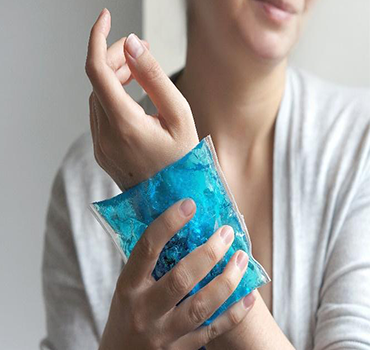De Quervain’s tenosynovitis
Home / De Quervain’s tenosynovitis
De Quervain’s tenosynovitis
Get AppointmentWhat is De Quervain’s tenosynovitis?
De Quervain’s tenosynovitis is an inflammation of the sheaths of the tendons (tenosynovium) that move the thumb away from the hand. It is technically referred to as stenosing tenosynovitis. Both the tendons and their surrounding tissue sheaths are involved in the area where the tendon has to go through a small tunnel of bony and fibrous tissue at the wrist. The inflamed tenosynovium becomes painful in the tunnel area.
Causes of De Quervain’s Tenosynovitis
This condition occurs most often between the ages of 30 -50 years. Quite often the cause is unknown although tendon sprain and overuse during repetitive movements can predispose to the development of this condition. Some of the risk factors include:
- Women, especially mothers with young infants are more likely to be affected due to a combination of overuse, hormonal changes, and fluid retention. Improper lifting technique can especially predispose to the development of this condition and it is also addressed as the mother’s Thumb.
- Professions or hobbies involving repetitive wrist or hand motions such as with musicians, dental hygienists, golfers, mountain bikers, typists, and video game players. Other commonly used names used for the same condition include texting thumb, gamers’ thumb, washerwoman’s sprain, and designer’s thumb.
Symptoms
Symptoms may include:
- Pain or tenderness at the base of the thumb
- Pain when pinching
- Swelling over the thumb side of the wrist
- A snapping or catching sensation when moving the thumb
- Numbness on the back of the thumb radiating to the index finger
Diagnosis
Your doctor will ask about your symptoms and medical history. A physical exam will be done.
The Finkelstein test is often done to help make the diagnosis. Make a fist with your thumb inside your fingers and bend your wrist toward your little finger. If this causes pain at the wrist below your thumb, you may have De Quervain’s tenosynovitis.

Treatments
The treatment option will vary depending on multiple factors such as the duration of symptoms, severity & impact on your daily activities, previous treatments, and their results. It can be self-limited and may resolve without intervention. For most individuals, non-surgical treatment options suffice with very few requiring surgery.
Treatment options include-
- Rest- This includes avoidance of provoking activities and heavy work with the affected hand for several weeks. Rest provides an opportunity for the symptoms to settle. In mothers with young infants, changing the lifting technique and breastfeeding position can make a difference.
- Icing – Ice can help in reducing pain and swelling. Avoid applying the ice directly to the skin. Ice can be wrapped in a towel and used for a few minutes (as tolerated), a few times a day.
- Splinting – The splint may be required to be worn for a few weeks. It works by restricting the movement of the thumb thereby providing an opportunity for healing to occur. The combined use of splints and steroid injections is more effective than splinting alone.
- Medications – Painkillers can provide temporary relief and may include anti-inflammatory medications. It is important to use these medications as directed by your doctor.
- Physiotherapy– This involves a combination of stretching and strengthening exercises to improve hand function. Exercises are best learned under the supervision of an experienced therapist. Once you have learned the correct technique, you can continue with these at home. Exercises have been shown to improve the duration of pain relief when used in combination with steroid injection and splinting.

Steroid injections – In case the pain does not settle, then your doctor may consider injections. Steroids are effective anti-inflammatory medicines and are commonly used treatment modalities with near-complete relief with one or two injections.
Your physician will recommend surgery based on the severity of your pain symptoms and response to non-surgical treatment methods. The outpatient surgical procedure involves opening or cutting the inflamed part of the tendon sheath to relieve the pressure on the tendon and allow free movement of the wrist. After the surgical procedure, a wrist splint with your thumb and fingers free and mobile is applied for a month. Your surgeon will also instruct you on exercises to strengthen your wrist.
GET APPOINTMENT
Schedule Appointment : Your Path to Specialized Care
Get rid of your pain, stress, and enduring with our 24/7 dental services. It's a priority to relieve the pain in surgeon as much as possible. 90% of customers claim that they would come back & recommend us to others.
